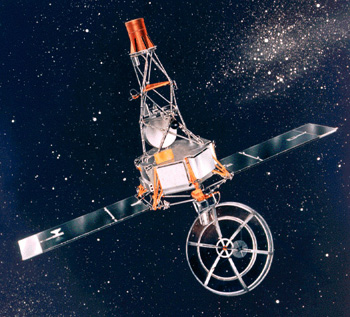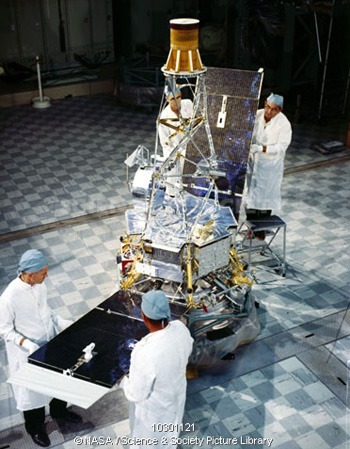Mariner 2

Artwork of Mariner 2 in flight.

Mariner 2 being inspected by engineers.
Mariner 2, the second in the Mariner series of US unmanned interplanetary probes, was the first spacecraft to successfully encounter another planet. It flew past Venus at a distance of 35,000 kilometers (22,000 miles) on 14 December 1962, sending back data on the temperature distribution of the planet's surface and making basic measurements of Venus' atmosphere.
Mariner 2 was an exact copy of its sister craft, Mariner 1, which was lost when its launch vehicle had to be destroyed. Both these early Mariners were stripped down versions of the Ranger probes used to investigate the Moon.
| launch date/time | Aug 27, 1962; 06:53:14 UTC |
| launch vehicle | Atlas-Agena |
| launch site | Cape Canaveral Air Force Station |
| size | 1.04 m across hexagonal base 3.66 m high |
| mass | 203 kg |
The flight of Mariner 2
Mariner 2 was launched by a two-stage Atlas-Agena rocket. After separation of the Atlas first stage, the Agena booster fired for the first time to put Agena-Mariner 2 into a 118-kilometer-high Earth parking orbit. A second burn by Agena, 980 seconds later, followed by separation of the booster, put Mariner 2 onto an Earth escape trajectory. Three-quarters of an hour later, Mariner's solar panels opened out, to supply the spacecraft with power it would need to run its science experiments, which began to be turned on a couple of days later.
On 8 September, Mariner suddenly lost attitude control, possibly due to collision with a small object, but this was restored by the onboard gyroscopes 3 minutes later. En route to Venus, one of the solar panels failed but by this time the spacecraft was close enough to the Sun to get adequate power from its remaining panel. On 14 December, the probe's radiometers were turned on. Mariner 2 approached Venus from 30° above the dark side of the planet, and passed below the planet at its closest distance of 34,773 km at 19:59:28 UT, 14 December 1962. Its last transmission was received on 3 January 1963. The probe, now lifeless, remains in orbit around the Sun.
Scientific harvest
Mariner 2 discovered the slow retrograde (backward) rotation rate for Venus, hot surface temperatures and high surface pressures, a predominantly carbon dioxide atmosphere, continuous cloud cover with a top altitude of about 60 kilometers, and no detectable magnetic field. It also showed that in interplanetary space the solar wind streams continuously and the cosmic dust density is much lower than in the near-Earth region. Improved estimates of Venus' mass and the value of the astronomical unit were made.
Spacecraft and instruments
Mariner 2 consisted of a hexagonal base, 1.04 meter across and 0.36 meter thick, which housed the electronics for the science experiments, communications, data encoding, computing, timing, and attitude control, and the power control, battery, and battery charger, as well as the attitude control gas bottles and the rocket engine. Atop the base was a tall pyramidal mast on which the science experiments were mounted. Attached to either side of the base were rectangular solar panel wings with a total span of 5.05 meters and width of 0.76 meter. Attached by an arm to one side of the base and extending below the spacecraft was a large directional dish antenna.
Mariner 2 was powered by two solar panels, one 183 centimeters by 76 centimeters and the other 152 centimeters by 76 centimeters. These powered the craft directly or recharged a 1,000 watt-hour sealed silver-zinc cell battery, which was used before the panels were deployed, when the panels were not illuminated by the Sun, and when loads were heavy. Communications consisted of a 3-watt transmitter capable of continuous telemetry operation, a high-gain directional dish antenna, a cylindrical omnidirectional antenna at the top of the instrument mast, and two command antennas, one on the end of either solar panel, which received instructions for midcourse maneuvers and other functions.
Propulsion for midcourse maneuvers was supplied by a monopropellant (anhydrous hydrazine) 225-newton retrorocket. Attitude control with a 1-degree pointing error was maintained by a system of nitrogen gas jets. Overall timing and control was performed by a digital Central Computer and Sequencer. Thermal control was achieved through the use of passive reflecting and absorbing surfaces, thermal shields, and movable louvers.
The scientific experiments were mounted on the instrument mast and base. A magnetometer was attached to the top of the mast below the omnidirectional antenna. Particle detectors were mounted halfway up the mast, along with the cosmic ray detector. A cosmic dust detector and solar plasma spectrometer detector were attached to the top edges of the spacecraft base. A microwave radiometer and an infrared radiometer and the radiometer reference horns were rigidly mounted to a 48-centimeter diameter parabolic radiometer antenna mounted near the bottom of the mast. All instruments were operated throughout the cruise and encounter modes except the radiometers, which were only used in the immediate vicinity of Venus.


